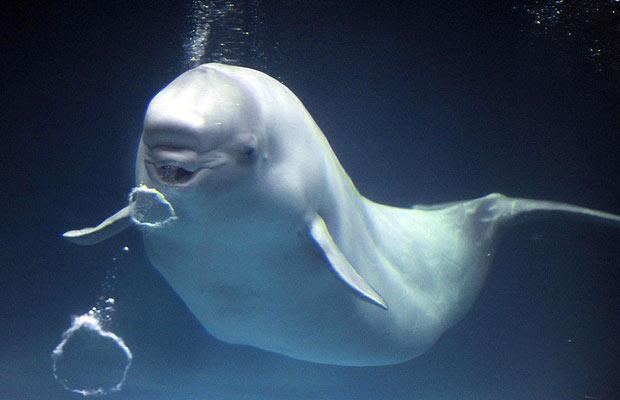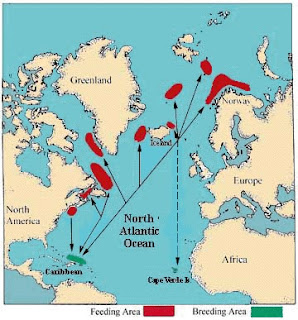|
Whale blow, Witless Bay, Newfoundland, June 25, 2016 |
Whale watching is a must do in Atlantic Canada. Sea waters here are among the most productive portions of the earth's ocean with extreme depth and mixed with cold fresh water from St Lawrence River; Accordingly one of the largest whale gatherings on this planet takes place here every year.
Whales are the largest marine mammals. Adult whales range in size from 2-3 meters and 300 lbs of a dwarf sperm whale to as big as 34 meters and 190 tons of a blue whale, the largest earth creature that has ever lived. Average life expectancy of whales varies by size, from 29 years of Killer whales to 80-90 years of Blue whales.They are highly intelligent mammals and developed complex communication patterns as well as variety of social, entertainment and play behaviors. Whales are very attractive in display and can be trained to perform some difficult circus shows. For this reason small whales are popular targets to capture for aquariums and zoos.
|
Bubble ring by Beluga, a complex play behavior, credit to: www.trekearth.com |
Whales evolved from land-living mammals, and as such they have to breath air into lungs regularly. Whales cannot survive on the ground, but could hold their breath in deep water for long periods. Sperm whale, for example, makes some longest dives achieved by marine mammals which could last up to an astonishing 90 minutes. Same as human nose, whales have nostrils on top their head called blowhole, leading all the way to their lungs; while whale cannot breath like us through mouth but only blowholes. So whale have to reach the water surface to breath air, where they open the blowholes (blowholes were covered when whale submerged) and exhale air explosively, forming a small fountain of misty air called whale blow, visible from far away. Keep in mind whales don't spray water but only air, contrary from what you may seen in the movies. The white splash from their blowhole is not water but vapor, caused by water resting on top of the blowhole when whale surfaced. This followed by inhalation of fresh air, and then a new drive begins. The whole process lasts few seconds.
This makes possible the whale watching. Whales surface the water when breath, and at that moment they are visible from boat or even on nearby shore. Their blowholes, part of the back, dorsal fins, sometimes tails, all expose to the air. From the size, shape and color of whales' dorsal fins an experienced guide can tell their type. Like this:
|
Minke Whale, Riviere de loup, Quebec, June 15, 2016 |
or this:
|
Humpback Whale, Witless Bay, Newfoundland, June 25, 2016 |
If lucky you may spot a whale breaching in a boat tour, most likely by humpbacks or killer whales, a behavior that whale jump with most part of body leave the water and whirl around, often several times in a row. What motives whale breaching are uncertain. General believe is the transmission of messages, to entertain, or to mark a territory. Take humpbacks for example, they might use breaching communication in times to notify others that the environment is too noisy. Humpbacks are superstars in whale watching tour due to their classic breaching display. Apart from that, these whales sometimes roll over in the water when eating too much, or swim on its back to entertain.
|
What whales are after: Atlantic Caplin |
Whale watching in wild sounds might a bit matter of luck, and that's why it only hosted on the waters with rich cetacean population. Fortunately in Atlantic Canada whales are pretty much a guaranteed seen in summer. All you need to do is to onboard a tour boat, drive to the place where whales frequently appear, and wait. They will never let you down.
But that's not the case in winter. By then whales already left Canada and arrived Caribbean sea. They are migrating mammals with most of the species take extensive migration all year round, time coupled for food and breeding. Take northern Atlantic whales for example, their favorite food Caplins usually live around Arctic area, but will migrate to Atlantic Canada in summer in dense swarms. For whales, nothing beat this northern buffet! They swim thousands of miles to Canadian shore for the Caplin shoal, and enjoy couple of months lay-back life in this giant food bucket.
|
Migration route of North Atlantic whales |
Technically adult whales are able to feast on this delicious meal for as long as they want by following Caplins every where all year round, but in reality Atlantic whales have to turn back to Caribbean in winter for mating and breeding because whale calves are too small to build sufficient fat to survive the frigid sea water in northern Atlantic. So each fall they leave Canada and travel long distance to reach warm, shallow Caribbean waters, where they mate a partner, calving and raise young. Next spring this round-trip migration starts all over again, when Caplins back to Canadian water, and whale calves grow big enough. Is that sounds like what retired Canadians do? Cool summer in Canada and warm winter in Caribbean?
Food abundancy is what whales migrate for. The patterns of whale migration varies from species to species or by geographic areas, typically last few thousand miles. Record holder is the grey whale, who makes a powerful pole to pole migration every year, traveling 10-12 thousands miles. It is the longest known migration of any creatures on earth.
Maritime Canada is one of the major destinations whales heading in summer, with most of the species arrive in June or July. The region is the home of some most spectacular whale watching sites in the world, good for Minke, Fin, Beluga, Hampback, and Blue whales. Right whales, a close-to-extinct species, sometimes seen off at St. Lawrence Bay too. Quebec is one of the few available places to spot Beluga.
剩下的看我的博客吧, 拉點瀏覽量: http://chinadiansalmon.blogspot.com/2016/07/whale-watching-in-atlantic-canada.html


